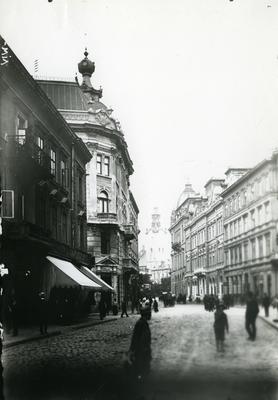Vul. Hnatiuka, 5-7 – a music school (former residential building)
This former apartment house was adapted for an educational establishment (a music school for children). It was constructed in 1876–1877, designed by an architect Felix Księżarski. The Neo-Renaissance building was built in the center of Lviv. Due to its style and planning layout, it is a typical example of architecture of the 1870s. The double house number implies that after a reconstruction (1914) two separate townhouses were connected into one block.
Architecture
A four-storey building is located in a central part of Lviv, on the corner site adjacent to the crossroads of vul. Hnatiuka and vul. Sichovykh Striltsiv, nearby prosp. Svobody, the former Hetman Ramparts (Wały Hetmańskie). It has two front angle wise façades — a longer north façade with eight window axes, on the side of vul. Hnatiuka, and a shorter north-west four axes one, on the side of vul. Sichovykh Striltsiv. There is a three window trihedral corner block between them. The body of the townhouse is included into the quarter's perimeter, its façades border with the sidewalks.
The façades' composition has a quite static character, it is dominated by horizontal divisions — cornices divide the façades into four tiers. On the upper floors level, there are rows of uniform windows with simple trimmings and small cornices. The lower storey is filled with large display windows of commercial premises, and entrance portals. Below the window openings of the second and third storeys, there are small relief panels, between the windows on the top floor there are pairs of pilasters with Corinthian capitals. Entablature on the façade's top has consoles, and there is a balustrade above it. The corner part of the building is covered by an octagonal hipped roof which is a dominating feature of the exterior, which enlivens the building's sillhouette. Decorative details are used quite modestly. Neo-Renaissance-style moldings play the major role in the building's décor, this is typical of the 1870s architecture.
The building site has a pentagonal shape. The base of the building's block (its north part) is made of two wings unfolded angle wise adjacent with their fronts to vul. Hnatiuka and vul. Sichovykh Striltsiv. Behind them, at the back of the land plot, there is an enclosed courtyard confined on the south with the triple knee of a side wing (its blind rear wall can be seen from the nearby courtyard, from vul. Hnatiuka, 3).
The frontal block has two rows of apartments in its layout, while the side wing has one. Interior communications are based on mixed enfilade corridor scheme. Main staircase and the entrance hall are located in the northern block, with the entrance through the arched doorway from the side of vul. Hnatiuka. There is an other portal on the corner. It also has an arch shaped opening and serves as an entrance to a store. It is flanked with a pair of Doric columns and small oval windows.
Personalities
Ferdynand Kassler — architect, developer.
Felix Księżarski — architect.
Helena Sanguszko — princess, owner of
the house.
Tereza Sapiega (Sapieżyna) — princess, owner of
the house.
Elżbieta Sokołowska — owner of
the house.
Stanisław Sokołowski — owner of
the house.
Sources
1. State Archive of Lviv Oblast (DALO 2/1/2847).
2. DALO 2/1/2853.
Media Archive Materials
Related Pictures











